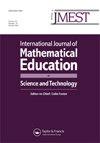大学拓扑学的一般例子:个案研究
IF 0.6
Q3 EDUCATION & EDUCATIONAL RESEARCH
International Journal of Mathematical Education in Science and Technology
Pub Date : 2023-10-19
DOI:10.1080/0020739x.2023.2256732
引用次数: 0
摘要
在构造证明时,专家数学家使用示例和可视化表示作为其非正式数学推理的一部分。相比之下,本科生推理和创造证明的方式是一个开放的研究领域,尤其是在高等数学领域。此外,对学生在拓扑学中的推理能力的研究在很大程度上是未知的。基于Gallagher[(2020)]的研究结果。在入门拓扑学中识别结构:图表,示例和手势。博士论文,西弗吉尼亚大学,摩根敦,西弗吉尼亚州。https://researchrepository.wvu.edu/etd/7599/ (ms# 8610)],我们提出了一个本科生的案例研究,在一般拓扑学的第一门课程中,她在提出正式证明和反例之前在论证中使用一般例子。我们讨论了她在证明真实陈述和反驳虚假主张时使用一般例子时出现的模式。我们将该学生的通用示例与数学中其他内容领域的文献中的其他通用示例进行比较和对比,我们认为通用示例不是一刀切的,而是必须符合目的。我们的结果表明,一般的例子可能是特别有用的学生写证明时,他们可能无法获得具体的例子。本文给出的结果来自于对第一作者博士论文(Gallagher, 2020)收集的数据的分析。披露声明作者未报告潜在的利益冲突。人类参与者披露人类参与者参加了这项研究。这项研究被列为最低风险;在研究期间没有预期的身体或精神风险。本研究的伦理批准由西弗吉尼亚大学机构审查委员会批准,批准号为1711838593。所有受试者被告知,他们将被视频和音频记录解决数学问题,他们提供的任何数据可能用于研究目的并发表在学术手稿中。所有研究受试者都签署了同意书,并且可以随时撤回同意书和/或要求从我们的数据语料库中删除他们的数据。注释1引导者忽略了包括集合U和V必须是非空的条件,以形成x的分离。在第7次会话中,Stacey和引导者都没有承认这一遗漏。本文章由计算机程序翻译,如有差异,请以英文原文为准。
Generic examples in undergraduate topology: a case study
AbstractExpert mathematicians use examples and visual representations as part of their informal mathematics reasoning when constructing proofs. In contrast, the ways undergraduates reason and work toward creating proofs is an open area of investigation, particularly in advanced mathematics. Furthermore, research on students’ reasoning in topology is largely unexplored. Building on findings from Gallagher [(2020). Identifying Structure in Introductory Topology: Diagrams, Examples, and Gestures. Doctoral Dissertation, West Virginia University, Morgantown, West Virginia. https://researchrepository.wvu.edu/etd/7599/ (MS #8610)], we present a case study of an undergraduate taking a first course in general topology and her use of generic examples in argumentation prior to producing formal proofs and counterexamples. We discuss patterns that emerged in her use of generic examples when proving true statements and disproving false claims. We compare and contrast this student’s generic examples with other generic examples in the literature from other content areas within mathematics, and we argue that generic examples are not one-size-fits-all but rather must be fit-for-purpose. Our results suggest that generic examples may be particularly useful for students writing proofs when they may not have access to specific examples.KEYWORDS: Generic examplesdiagramstopologyproofargumentation AcknowledgementsThe results presented in this manuscript are derived from an analysis of data collected by the lead author for their doctoral dissertation (Gallagher, 2020).Disclosure statementNo potential conflict of interest was reported by the authors.Human participants disclosureHuman participants took part in this research. This research was classified as minimal risk; no physical or mental risks were anticipated during the study. Ethics approval for this research was granted by the Institutional Review Board at West Virginia University under protocol/approval number 1711838593. All subjects were informed that they would be video and audio recorded solving mathematics problems, and any data they provided may be used for research purposes and published in scholarly manuscripts. All research subjects signed consent forms and were free to withdraw their consent and/or request to have their data removed from our data corpus at any time.Notes1 The facilitator neglected to include the condition that the sets U and V must be nonempty to form a separation of X. Neither Stacey nor the facilitator acknowledged this omission during Session 7.
求助全文
通过发布文献求助,成功后即可免费获取论文全文。
去求助
来源期刊

International Journal of Mathematical Education in Science and Technology
EDUCATION & EDUCATIONAL RESEARCH-
CiteScore
3.30
自引率
11.10%
发文量
123
期刊介绍:
Mathematics is pervading every study and technique in our modern world, bringing ever more sharply into focus the responsibilities laid upon those whose task it is to teach it. Most prominent among these is the difficulty of presenting an interdisciplinary approach so that one professional group may benefit from the experience of others. The International Journal of Mathematical Education in Science and Technology provides a medium by which a wide range of experience in mathematical education can be presented, assimilated and eventually adapted to everyday needs in schools, colleges, polytechnics, universities, industry and commerce. Contributions will be welcomed from lecturers, teachers and users of mathematics at all levels on the contents of syllabuses and methods of presentation.
 求助内容:
求助内容: 应助结果提醒方式:
应助结果提醒方式:


